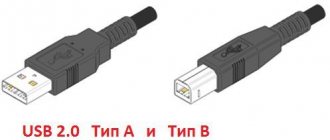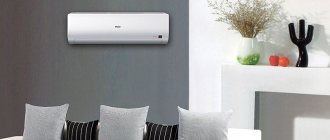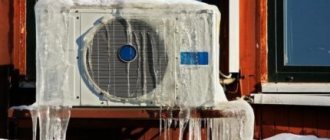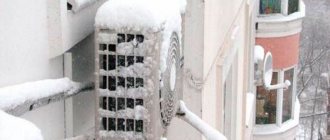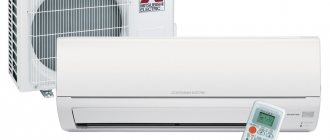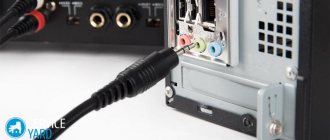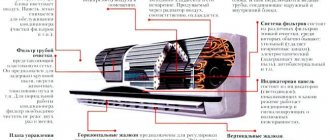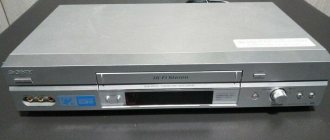Requirements
It must be remembered that the electrical connection diagram for an air conditioner used in everyday life differs significantly from the similar connection of semi-industrial models that are installed in offices. Households have only a single-phase connection.
- direct connection via socket;
- separate wiring to the electrical panel.
The first option is ideal for all household devices - they are everywhere put into operation only in this way. Connecting any air conditioning system is carried out in several steps, which must be strictly followed when you decide to do everything yourself.
Connection diagram of the air conditioner to the electrical network
The figure shows a diagram of connecting the air conditioner to the electrical network, as well as various connections between the system modules; in addition, you will definitely need a circuit diagram of the air conditioner of the purchased model.
Air conditioner electrical equipment
All the main elements of air conditioning systems cannot work on their own. All operation is ensured by the electrical circuit of the air conditioner. The general scheme includes several main parts. connection to the indoor unit is carried out using the Terminal terminal block. The block itself has several terminals. N is the electrical neutral, No. 2 supplies power from the control board to the compressor, No. 3 ensures the fan operates at first speed, and No. 4 at second speed. The fifth terminal supplies power to the 4-way valve actuator when entering heating mode.
In the compressor itself there are three terminals: C, R and S, indicating, respectively, the common terminal of the windings, the working winding and the starting winding of the compressor motor for phase shift. In addition, the circuit includes protection against overloads and overheating, as well as terminals for connecting a fan, capacitor, solenoid valve and other elements.
Do I need a circuit breaker or RCD?
To understand the essence of the issue, you need to understand in detail the purpose of these protective devices:
- Regulatory regulations for design and construction, as well as PUE and GOST R 50571.8 states: connecting an RCD depends on the danger of electric shock and the type of device plugged into the outlet. It follows that not all sockets for air conditioning are connected via an RCD.
- These RCDs are installed to protect people from electric shock when the insulation is poor. But all the boxes of split system modules are made of plastic, that is, if a person directly touches the body, he cannot be harmed.
- The peculiarity of residual current devices is that they cannot protect a person from a short circuit: the RCD simply does not have time to turn off. After all, from the laws of physics it is known that the current speed in a conductor is 300 thousand km/sec, and the response time of any protective device, including an RCD, is 0.02-0.03 seconds.
- A circuit breaker is a protective device for wires that are selected according to the power of the equipment. And in the event of increased load on the network or a short circuit, the machine is triggered and saves one or another device from overheating and failure.
From all of the above, we can conclude that installing an RCD for climate control equipment is not so important, but circuit breakers for protection must be installed.
Work order
The first step is to select the set of tools and materials needed to install the connection. Next, carefully study the diagrams proposed by the manufacturer. After familiarizing yourself with the rules and requirements, you can proceed to the direct laying of cables to connect the terminals of the blocks.
Socket selection
To connect through a socket, the latter must meet certain requirements that are aimed at the efficiency and safety of the device.
- A differentiated relay or reliable grounding is a mandatory criterion when choosing.
- It is acceptable to use copper wires with a high-quality cross-section.
- The socket is connected to the panel only through a circuit breaker.
It is necessary to turn your attention to new generation European sockets. They fully comply with the manufacturer's requirements
They are well equipped and protected against power surges.
A differentiated relay is necessary if there is no grounding
Wire selection
When choosing a wire, you need to pay attention to its cross-section; it must exactly match the manufacturer’s requirements stated in the instructions. The cross-section required for household appliances is 1.5-2.5 square, the current should not exceed 19 A
If the distance between the device and the shield is within 10 m, then sections with a diameter of one and a half square meters. mm. will be sufficient. However, at a distance greater than 10 m, the diameter should also increase.
It is also important to remember that laying wires near heating or gas supply system pipes is strictly prohibited; the minimum distance between them is 1.5 m. Electrical harnesses must be placed in a protective corrugation and then secured with clamps
Evaporator connection
Installing the connection of the blocks is identical and will not cause you much difficulty
It is important to follow the rules below and observe safety precautions when working with electricity.
- First, remove the plastic front panel.
- Next, remove the protective cover and cable clamps.
- Route the wires through the wall opening that is located behind the air conditioner or on the side wall.
- Afterwards, it is necessary to remove the protective tape from the cores at a distance of 30-40 mm from the edge.
- Insert the bare wires into the terminals and tighten the fastening screws securely.
- The next step is to strengthen the outgoing wires.
- After completing these manipulations, reassemble the device in reverse order.
Upon completion of the installation work, check the correctness of this connection - check the result obtained with the manufacturer’s diagrams. Only after a thorough check is it permissible to turn on and use the air conditioner. https://www.youtube.com/watch?v=ogjzdCEM080
First way
Installation work begins with laying cables connecting the evaporator to the external part of the system.
For this:
- A wire is laid for connecting the air conditioner modules;
- A separate line is installed if the system has high power and is equipped with a cable and a circuit breaker that protects the system from possible overloads;
- The air conditioner is directly connected to the electrical network. For this purpose, an ordinary standard socket is used if the power of the device is in the middle range.
Implementation of the latter method of connecting an air conditioner is possible in several cases:
- Low power equipment;
- Installation of a mobile or window class system;
- Temporary installation of the device;
- The electrical network in the apartment is designed for sufficiently high power;
- Use the selected line for air conditioning only.
Attention! The internal module of the system is connected through reinforced sockets, providing a circuit breaker near the climate control equipment.
The presence of personal protection for an air conditioner is mandatory, since during operation the device operates in different modes. Depending on the selected mode, the power of the equipment can vary from maximum to minimum and vice versa. If the set parameters are exceeded, the machine will prevent the air conditioner from malfunctioning.
The delivery package of any climate control equipment always includes instructions for installation, connection and use.
The documentation reflects:
- System operation diagram;
- General connection diagram that should guide the user when performing installation work;
- Electrical diagram of the air conditioner, reflecting the order of work when connecting the indoor and outdoor units.
For the convenience of the user, the information is duplicated. It is located on the inside of the cover of the indoor module and on the body of the unit mounted outside the house. When installing the air conditioner yourself, this greatly simplifies the installation work.
The evaporator is connected to the terminals located in a special box under the front panel. The split system is installed inside the room.
Requirements for installing air conditioners
In order for the air conditioner to bring maximum benefit, you must follow some rules:
- Choose exactly the model that matches the parameters of the room (size, availability of equipment, etc.).
- Correct installation.
- Compliance with the rules of operation and prevention.
The air conditioner has two blocks, each of which is assigned certain functions. The outer one is the condenser, and the inner one is the evaporator. They are connected using wires and tubes in which freon operates.
It is very important to choose the right location to install the system. In this case, you should take into account the weight of the block, free access to it, etc. The air conditioner should be installed closer to the window
The air conditioner should be installed closer to the window
The outdoor unit must be located on a strong wall that can support a weight of more than 60 kg. Installation should not be carried out on aerated concrete. The external unit must be protected from environmental influences. This can be done with the help of fences and canopies.
When installing the indoor unit, please consider:
- The distance from the external to the internal unit should be minimal. This will ensure higher efficiency.
- The evaporator must not be obscured by curtains, furniture, etc.
- There must be a distance of at least 3 meters between the furniture and the indoor unit.
- The system cannot be installed above batteries.
- Provide free access.
- The distance from the block to the ceiling must be at least 10 cm.
It is necessary to ensure tightness and reliability of the air conditioner mounting. If a line is used to connect the blocks, then vacuumization of the connections will be required.
General diagram of the air conditioner
Each capacitor contains basic elements that perform specific functions. Inside the outdoor unit there is a condenser that converts the gaseous refrigerant into liquid form. Another important element is the throttle or expansion valve. With its help, the refrigerant pressure decreases as it approaches the evaporator. The evaporator itself is made in the form of a radiator installed in the indoor unit.
During a decrease in pressure, this is where the refrigerant transitions from liquid to gaseous form. With the help of a compressor, the refrigerant is compressed and circulated in a circle. Fans create air flows necessary to blow over the evaporator and condenser. All main elements are connected using copper tubes. As a result, a closed circuit is formed through which the refrigerant circulates.
Scheme of a household split system
Split systems are traditionally used in everyday life for air conditioning. True, in addition to this version of household air conditioners, other designs are also used. However, as practice shows, the operation of other types of climate control equipment is significantly less common.
Air conditioner design features
What is a household split system from a structural point of view?
Actually, this is air conditioning equipment, consisting of two separate modules (blocks):
- Block for internal installation.
- Block for external installation.
Internal installation means the installation of one part of the air conditioner structure (a unit for internal installation) directly inside the room where ambient air treatment is required.
Accordingly, external installation means the installation of another part of the air conditioner structure (a unit for external installation), directly outside the room. As a rule, installation in this case is carried out on the street side of the wall of a house or premises for other purposes.
But first, we recommend that you familiarize yourself with where you can install an air conditioner in a private house and apartment.
A classic example of a split system (air conditioning units for domestic use), structurally consisting of two separate modules - external and internal
Connection of indoor and outdoor modules
At the next stage, the user needs to connect both modules into a single working system.
It is planned to connect the modules mechanically with pipelines for refrigerant circulation, as well as connect them electrically with an electric cable, respectively. This process is called laying the air conditioner route.
The procedure for connecting refrigerant circulation pipelines on the modules (the internal module of the split system is shown), as well as electrical conductors
Essentially, a household air conditioner contains several functional electric motors, each of which requires power supply:
- compressor motor;
- outdoor unit fan motor;
- indoor module fan motor.
In addition, the air conditioning system can be additionally equipped with electric motors, the operation of which drives the blinds, directing the outgoing air flow in the desired direction.
Blinds for regulating the outgoing air flow are usually included in the design of the indoor unit of a domestic air conditioning unit.
Demonstration of a fully assembled split system with installation of indoor and outdoor units, combined into a single structure through technological connections
Depending on the power level of the outdoor module of the air conditioning unit, two or more condenser cooling fans (installed in the outdoor module) can be used.
True, such options are rare for household climate control equipment. But for use in offices, split system designs with two fans are quite common.
Connecting an air conditioner (split system)
Did you like the video? Subscribe to our channel!
We all want to make our home as comfortable as possible. One of the indicators of comfort is temperature. An air conditioner will help us maintain the desired air temperature in the house.
The air conditioner connection diagram is of interest to many, since they are often installed in houses and apartments, as well as in offices, shopping and entertainment complexes and other institutions. Therefore, today we devote our article to such a topic as connecting an air conditioner with your own hands. In it we will tell you how to connect an air conditioner from an outlet, and also consider connecting a split system directly.
As always, we remind you that work related to electrical installations should be carried out only in compliance with safety regulations. It should also be noted that connecting the air conditioner to the electrical network must be done in accordance with the connection diagram (it is available in the passport of the electrical appliance).
How to connect an air conditioner from an outlet
To connect a stationary or mobile air conditioner from an outlet, we will need:
• power cable with 3 copper conductors with a cross-section of 2.5 mm² (for example, VVG 3x2.5 cable produced by Kabel-Arsenal LLC). The product of this plant has the following color markings for the cores: white, blue, yellow-green (g/g); • SCHUKO type socket with grounding contact; • three-core PVA wire with a cross-section of 1.5 mm² and a plug (if the connecting wire is not supplied with the air conditioner). For these purposes, the cable from Cable-Arsenal LLC is suitable - PVS 3x1.5-0.38 with the following color markings of the cores: brown, blue and yellow-green (w/g); • automatic switch (if it was not previously installed in the apartment panel).
In a pre-prepared groove from the shield to the installation box, we lay the VVG cable so that the end of the cable in it has a reserve length for reconnection.
Please note that it is recommended to install the socket at a height convenient for use.
After laying and fixing the cable, we connect it in the panel in the following sequence:
• core with white insulation - free terminal of the machine; • blue wire – free terminal of the zero bus; • yellow-colored conductor - any terminal of the grounding bus.
After laying the cables, we carry out finishing work and proceed to the installation of electrical accessories. In the installation box we strip the cable and connect the socket:
• wires of white and blue colors - the outermost terminal of the socket; • conductor of yellow/grey color – central terminal marked “PE” or .
If there is no connecting wire included with the air conditioner, then take the PVS wire, measure the required length and proceed to install the plug. To do this, unwind it, pass the wire through a special hole in the housing, clean it, terminate the stranded wires and connect:
• cores with brown and blue insulation – to the outer bolted connections of the plug; • yellow-green wire – to the central bolted connection of the fork marked .
After making the connection, fix the wire with a special bracket and assemble the plug.
Having disconnected the plug, we proceed to connecting the air conditioner. First you need to remove (lift) the panel, unscrew the screws holding the cover of the air conditioner terminal box, and remove it. We pass the second end of the wire through a special hole, strip it, terminate the stranded cores and connect it to a special terminal block:
• core with brown insulation – to terminal “L”; • blue wire – to terminal “N”; • yellow-green conductor – to the terminal with the sign or marking “PE”.
Next, close the lid, secure it with screws and close the panel. After installing the outdoor and indoor units of the air conditioner, we connect it to the outlet.
Air conditioner direct connection
Now let's look at how to connect the air conditioner to the electrical network directly. To connect the air conditioner in this way, you must use the same cable as in the previous connection option.
We lay it in a pre-prepared groove to the intended installation location of the indoor unit of the air conditioner. In this case, the end of the cable must have a reserve length for reconnection. After laying and fixing the cable, we connect it in the panel in the same way as the previous option.
After this, work is carried out on laying communications to connect the outdoor unit and finishing work. Next, the outdoor and indoor units of the air conditioner are installed and connected. When installing the indoor unit, remove the front panel, unscrew the screws holding the terminal box cover, and remove it. We pass the end of the cable through a special hole, strip it and connect it to a special terminal block:
• core with white insulation – terminal “L”; • blue wire – terminal “N”; • yellow-green conductor – terminal with the sign or marking “PE”.
Close the lid, tighten the screws, and then close the panel.
So, we have connected the air conditioner to the electrical network. You can also watch our video , which shows in detail how to connect the air conditioner with your own hands.
Location of socket for air conditioner
There are no regulatory documents on the location of the connection point for climate control systems to the electrical network. But you need to take into account the general rules for arranging lines. If this is done at the repair stage, it is necessary to form grooves - they run vertically or horizontally. Diagonal placement is prohibited. An alternative is to install wiring in protective boxes on top of the wall. Relevant for wooden walls.
When choosing where to locate the connection point, you need to consider:
- general design of the room;
- arrangement of furniture and other interior items;
- length of the power cord from the indoor unit.
The latter can be extended. To do this, remove the plug and connect the wire contacts to another using a special sleeve. Be sure to use insulating tape and heat shrink material. This way you can correctly position the connection point with the electrical wiring, regardless of the location of the indoor unit of the air conditioner.
What you need for installation
Consistent installation of a good split system when doing it yourself should be carried out taking into account ease of access during maintenance and ergonomic criteria - cold air should not have direct access to resting and working areas.
Approximate layout of split systems
The appropriate layout for installing a new air conditioner depends on the type of unit. The indoor module can be hung:
- to the left of the outside. The track is flat, the block is located 0.5 m from the wall. When turning the line onto an adjacent wall, the distance can be reduced to 0.1 m. The output and the route are masked under the cover of the equipment;
- to the left of the external wall without cable laying on the facade. Communications are laid in the corner of the room and hidden in a box. They hide him under the curtain;
- to the right of the outer wall. A typical solution involves laying the route in a box from the wall or laying it in a groove.
Advice! Use the groove laying technology if there is a ban on laying the route on the facade.
The outdoor unit can be positioned:
- on the loggia or balcony. The module is fixed frontally or sideways for ease of maintenance;
- on the glazed balcony. The window sash should be above the air conditioner. To prevent snow, moisture or debris from getting on the block, install a visor and plastic;
- under the window. This option is suitable for rooms without a balcony;
- next to the window. The block is placed at the level of the bottom of the window.
Air conditioner installation optionsTip! Do not use hollow or metal materials for the visor - they have low noise insulation.
Equipment
When installing climate control equipment yourself, you will need:
- perforator for making through holes for the output of pipes, cables, drainage pipes;
- a pipe cutter with a sharp blade or a hacksaw for metal;
- file and rimmer for trimming nicks;
- a pipe bender or a special spring for forming copper pipes;
- a drill with drills of different diameters to make holes for the mounting plates;
- pipe calibrator and flarer;
- wall chaser, which can be replaced with a chisel, sledgehammer and hammer;
- vacuum pump to start the air conditioning system;
- screwdrivers, hex wrenches, level.
Important! Cutting pipes with a hacksaw involves smoothing the edges with sandpaper
Materials and consumables
Use only high-quality materials, selecting them in accordance with the type of equipment:
- supply wire for power supply and connection of modules - power cable for 4 cores with a cross-section of 2 mm2 × 2.5 mm2;
- seamless copper pipes with the diameter specified in the instructions. The length of the products is equal to the length of the route, and the margin is about 30 cm;
- insulating insulation (foamed rubber) - sections along the length of the route;
- synthetic insulation;
- a corrugated hose with an internal plastic spiral for drainage or a propylene pipe along the length of the route plus 80 cm;
- L-shaped brackets (2 pcs.) for fixing the outdoor unit with a permissible load limit of 5 times the weight of the device;
- fastening elements - bolts, dowels and anchors, selected according to the type of brackets for the internal module.
Important! To hide the route you will need a plastic box 60x80 cm
What is the procedure for connecting the air conditioner to the electrical network?
It should be borne in mind that if several switches are installed nearby, their performance deteriorates due to poor cooling. In conclusion, I would like to warn all users once again: electricity does not forgive mistakes and inaccuracies, so when connecting yourself, be adequate with your skills, so that later you do not have to worry about extinguishing the wiring and repairing expensive climate control equipment.
In this case, you should be guided by the numbers of terminals and wires. After connecting both units, you should carefully check that the work was done correctly. The air conditioner can operate at different powers, so the circuit breaker should be installed on the connection line and near the outlet. As already noted, the air conditioner cannot be installed directly above the radiators. This is done directly into the outlet.
The procedure for introducing the device into the apartment’s energy system is as follows. Connecting the evaporator In principle, the method for connecting the system modules is identical, with the exception of minor nuances, so we present a detailed method for connecting the internal module, and the external one by analogy with it. In this case, the permissible current can reach 18 A.
Refrigeration circuit diagram
In practice, two basic methods are used to connect the air conditioning system. The ends of unused conductors must be carefully insulated with insulating tape.
To connect the indoor unit, you need to use reinforced sockets and install a circuit breaker nearby. It is better to cut a groove in the wall from an existing outlet and lay a power cable along it in a corrugated pipe to the split system unit, and then install a special outlet with a decorative cover into the wall. Low system power.
Installation of brackets The brackets are installed according to the markings, aligned and the bolts are securely tightened. For efficient operation of climate control systems, copper wires are used: for a single-phase connection - 3 wires, for a three-phase version - 5 wires. They can be connected either to a permanently laid electrical network or have a separately laid cable line. Wires are not laid near heating system and gas supply pipes; the standard distance between communications is no closer than a meter. First, the electrical wiring is laid. Errors when installing an air conditioner
